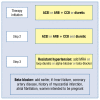TIMES TO ACT. Italian-Spanish-Polish-Uzbek Expert Forum Position Paper 2022. Dyslipidemia and arterial hypertension: The two most important and modifiable risk factors in clinical practice
- PMID: 36117294
- PMCID: PMC9550320
- DOI: 10.5603/CJ.a2022.0087
TIMES TO ACT. Italian-Spanish-Polish-Uzbek Expert Forum Position Paper 2022. Dyslipidemia and arterial hypertension: The two most important and modifiable risk factors in clinical practice
Abstract
Hypertension and lipid disorders are two of the main cardiovascular risk factors. Both risk factors - if detected early enough - can be controlled and treated with modern, effective drugs, devoid of significant side effects, available in four countries as different as Italy, Spain, Poland, and Uzbekistan. The aim herein, was to develop this TIMES TO ACT consensus to raise the awareness of the available options of the modern and intensified dyslipidemia and arterial hypertension treatments. The subsequent paragraphs involves consensus and discussion of the deleterious effects of COVID-19 in the cardiovascular field, the high prevalence of hypertension and lipid disorders in our countries and the most important reasons for poor control of these two factors. Subsequently proposed, are currently the most efficient and safe therapeutic options in treating dyslipidemia and arterial hypertension, focusing on the benefits of single-pill combination (SPCs) in both conditions. An accelerated algorithm is proposed to start the treatment with a PCSK9 inhibitor, if the target low-density-lipoprotein values have not been reached. As most patients with hypertension and lipid disorders present with multiple comorbidities, discussed are the possibilities of using new SPCs, combining modern drugs from different therapeutic groups, which mode of action does not confirm the "class effect". We believe our consensus strongly advocates the need to search for patients with cardiovascular risk factors and intensify their lipid-lowering and antihypertensive treatment based on SPCs will improve the control of these two basic cardiovascular risk factors in Italy, Spain, Poland and Uzbekistan.
Keywords: cardiovascular prevention; hypercholesterolemia; hypertension; single-pill combination (SPC).
Conflict of interest statement
Figures




References
MeSH terms
Substances
LinkOut - more resources
Full Text Sources
Medical
Research Materials
Miscellaneous

